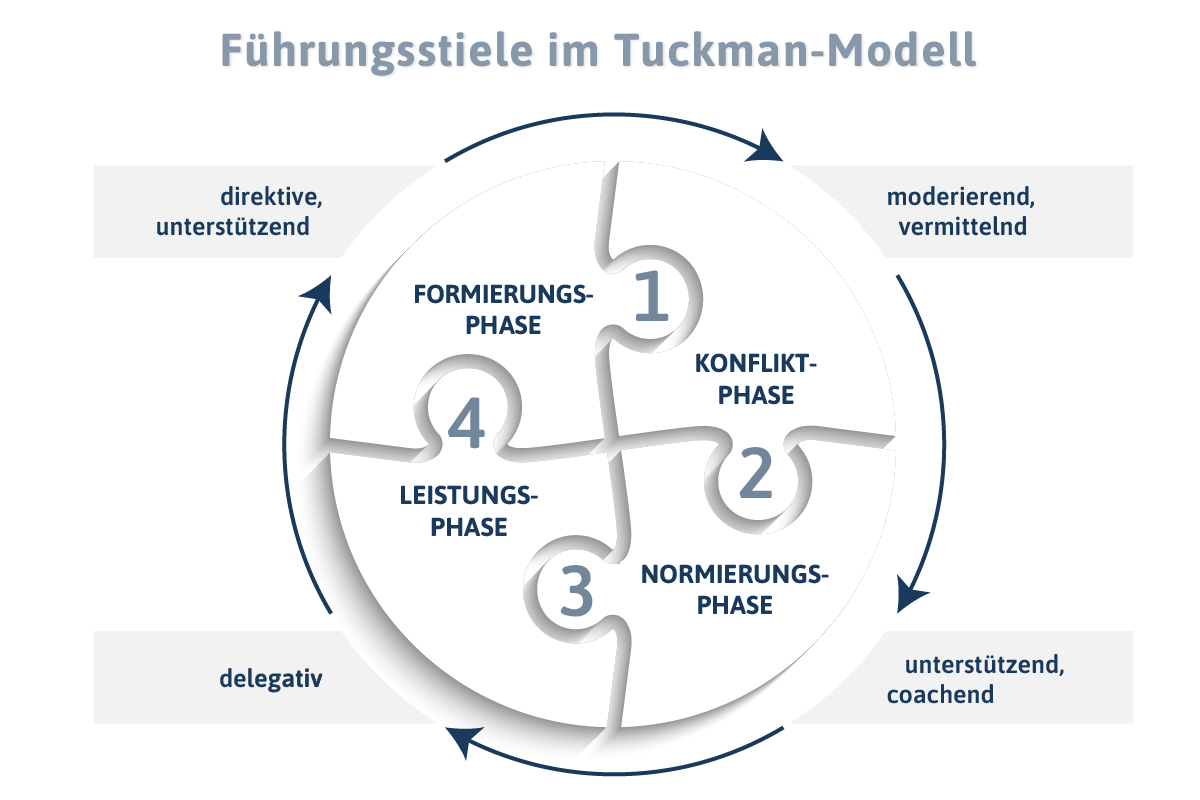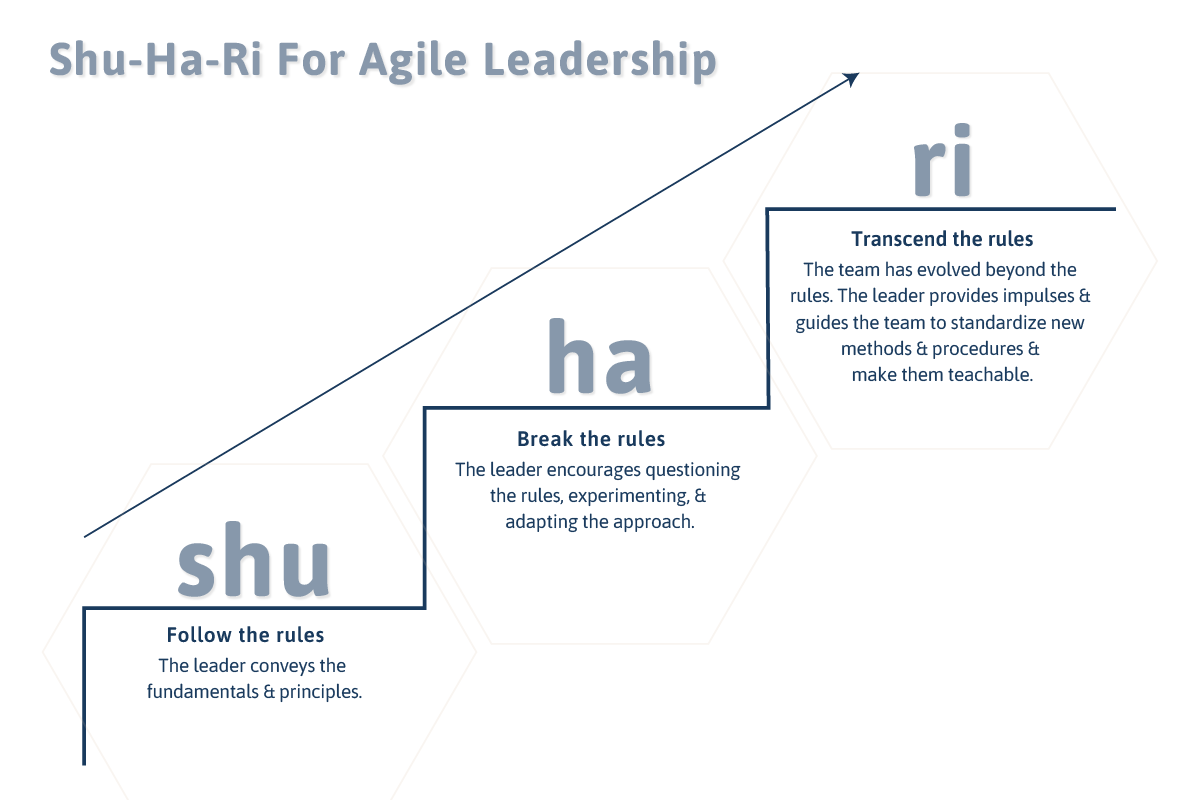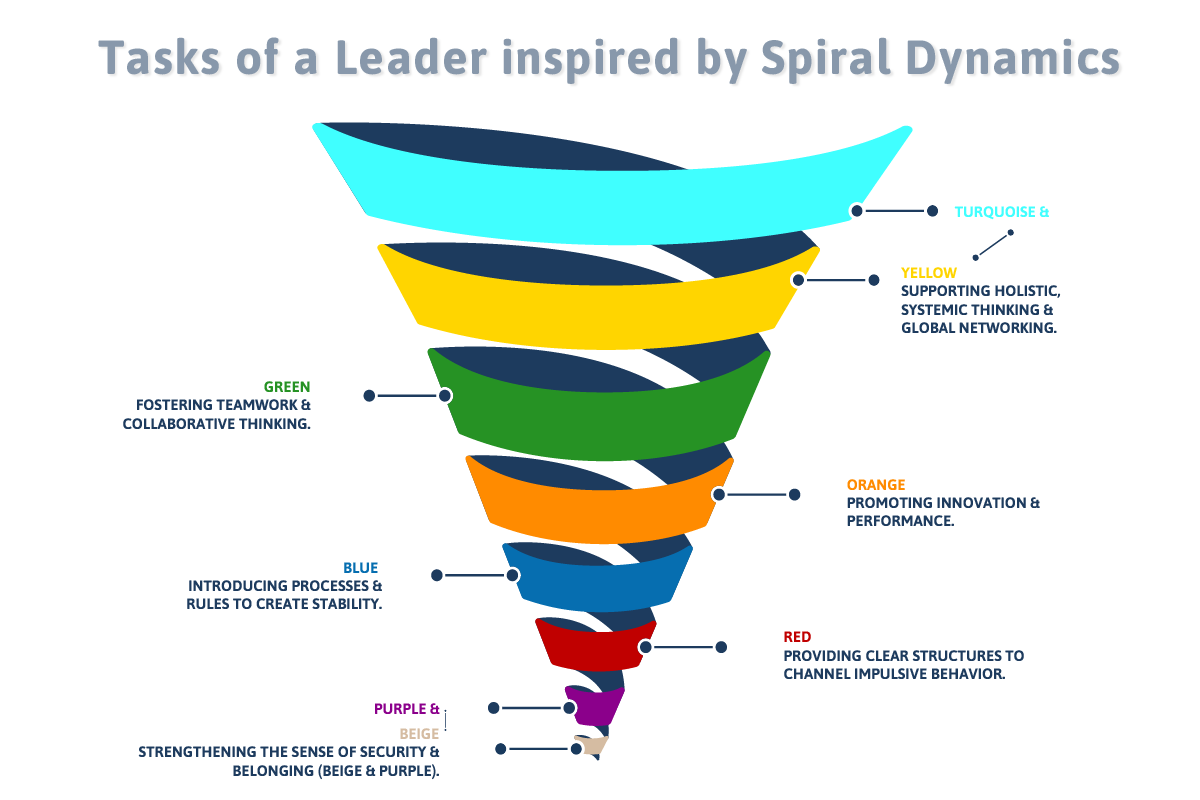Different Leadership Styles of the Agile Leader
Agile teams and entire organizations undergo development. Understanding different models to grasp this development is a useful tool for agile leaders.
Reality is always more complex and multifaceted than the models. However, these models provide a good guide for selecting appropriate methods and defining the next steps.
Agile Leader: Different Agile Leadership Styles According to Team Phase
According to Tuckman, a team goes through four phases after initial forming and after each change in composition: Forming, Storming, Norming, Performing. These team phases are also known as the team clock. Each of these phases requires different leadership styles to effectively support and guide the team.
Forming (Politeness Phase)
In the forming phase, also known as the “politeness phase,” the team comes together for the first time in its new composition. Members seek orientation and clear structures. They hold back and often lack the trust to speak openly.
An agile leader in the forming phase:
- Clearly presents the vision and goals of the product.
- Ensures training and adequate empowerment for the tasks.
- Clarifies agile principles and values with the team and how they will apply them in the specific environment.
- Fosters an environment of trust and openness by actively listening and encouraging team members to express their ideas and concerns.
- Supports the team in working self-organized by creating frameworks and defining initial roles and responsibilities.
Training in the agile frameworks creates a shared understanding and a common point of reference, which are essential for the subsequent phases..
Storming (Conflict Phase)
During the storming phase, tensions among team members become visible. Different opinions, views, and preferences clash. This indicates that team members have found enough trust to show their needs and preferences. The leader encourages team members to express their needs and creates conditions to channel them constructively.
An agile leader in the storming phase:
- Moderates conflicts constructively and promotes open communication to resolve misunderstandings and tensions.
- Encourages collaboration and emphasizes common goals to unite the team.
- Remains flexible and adjusts processes and structures to improve team dynamics.
- Sharpens the common understanding of how agile values and principles can be lived concretely in the given context.
Agile values and cultural work, along with specific methods like Nonviolent Communication or Liberating Structures, are particularly helpful here.
Norming (Normalization Phase)
In the norming phase, the team develops common norms and standards. Team members begin to work better together and build mutual trust.
An agile leader in the norming phase:
- Promotes self-organization by supporting the team in developing its own working methods and taking initiative.
- Strengthens mutual trust through regular feedback and positive reinforcement.
- Encourages continuous improvement through regular retrospectives and feedback loops.
Approaches like solution-oriented coaching, team-building measures, and celebrating successes can further strengthen the team and lead it into the performing phase.
Performing (Performance Phase)
In the performing phase, the team works efficiently and purposefully together. The members are well-coordinated and focused on the common goal.
An agile leader in the performing phase:
- Encourages the team to be creative and develop innovative solutions.
- Remains available as a resource and supporter to remove obstacles and assist the team as needed.
- Takes care of obstacles that are beyond the team’s direct influence.
- Encourages the team to celebrate successes and protects it from overworking.
In this phase, self-assessments or holistic agility checks can provide insights into how the team can further develop in a targeted manner.
The Bottom Line
The phases often transition smoothly into one another and can be reinitiated even in stable teams by new conditions. An agile leader is characterized in every phase by promoting self-organization, trust, continuous improvement, and team support. By adapting their leadership style to the respective phase of team development, they can effectively support the team and maximize its performance.
Agile Leadership According to the Shu-Ha-Ri Principle
The Shu-Ha-Ri principle comes from Japanese martial arts and describes three stages of learning and mastery: Shu (learning the rules), Ha (breaking the rules), and Ri (transcending the rules). This principle can also be applied to agile leadership to illustrate the development of a leader from initial adoption of agile methods to complete integration and further advancement of these principles.
Shu – Learning the Basics
In the Shu phase, agile leaders focus on learning and applying the basic principles and practices of agility. Key elements of this phase include:
- Applying Standard Methods: Leaders learn and implement proven agile frameworks and methods like Scrum, Kanban, SAFe®, or Flight Levels. This often involves conducting regular stand-up meetings, using iterations (sprints), and obtaining continuous feedback.
- Understanding Roles and Responsibilities: It is important to understand the various roles within an agile team, such as Product Owner, Scrum Master, and Development Team. Leaders should ensure that all team members clearly understand their roles and responsibilities.
- Internalizing Agile Values and Principles: The values and principles of the Agile Manifesto form the foundation. Leaders should internalize these values and actively integrate them into their work.
- Introducing Continuous Improvement: In the Shu phase, regular retrospectives are conducted to continuously improve processes and work methods.
Ha – Breaking the Rules
In the Ha phase, agile leaders begin to question and adapt the learned rules to better suit the specific needs of their team and organization:
- Adapting Methods: Leaders adjust agile methods and practices to the specific contexts and requirements of their team. This may involve combining elements of Scrum with Kanban or developing other hybrid approaches.
- Experimenting and Adapting: An experimental approach is encouraged in this phase, where new methods and techniques are tried to increase efficiency and effectiveness. Leaders encourage their teams to try new approaches and learn from the results.
- Expanding Agile Principles: The leader extends the application of agile principles to other areas of the organization, such as marketing, sales, or human resources. This helps establish a broader agile culture.
- Promoting Self-Organization: Teams are encouraged to self-organize more and make independent decisions. Leaders serve as coaches and mentors who support the team but do not directly control it.
Ri – Transcending the Rules
In the Ri phase, agile leaders have developed a deep understanding and extensive experience with agile principles and practices. They can transcend the principles and fully integrate them into their leadership philosophy:
- Complete Integration: Agile principles and values are fully integrated into the company culture and leadership practices. Decisions and actions are intuitively based on these principles.
- Fostering Innovation: Leaders in the Ri phase can foster a culture of innovation by supporting continuous learning and experimentation. They create an environment where creative ideas can thrive and changes are seen as opportunities.
- Role Model: These leaders serve as role models for others, inspiring through their actions and decisions. They promote a culture of trust, openness, and continuous improvement.
- Strategic Agility: Leaders think and act with strategic agility by developing long-term visions while responding flexibly to changes. They can master complex and uncertain environments by dynamically adjusting their teams and organizations.
The Bottom Line
The Shu-Ha-Ri principle offers a valuable framework for the development of agile leaders as well as for leading agile teams. By progressing through the phases of Shu (learning the rules), Ha (breaking the rules), and Ri (transcending the rules), leaders can continuously expand their skills and understanding. This enables them to effectively lead their teams and organizations and respond to the challenges of the modern, dynamic business world. Agile leaders who have internalized the Shu-Ha-Ri principle can establish a culture of agility and continuous improvement, promoting long-term success and sustainable development.
Spiral Dynamics in Agile Leadership
Spiral Dynamics is a model of human development and cultural change, which Frederic Laloux has applied to organizational development. It describes different levels of consciousness or “memes” that both individuals and organizations go through. Each meme represents a specific way of thinking, acting, and leading. In agile leadership, Spiral Dynamics can help understand the dynamics within a team or organization and develop appropriate leadership strategies.
The Levels of Spiral Dynamics
Spiral Dynamics describes eight main stages (memes), divided into two main categories: the first six memes (BEIGE to GREEN) as “First Tier” and the last two memes (YELLOW and TURQUOISE) as “Second Tier.” Each stage has specific characteristics and challenges, and they do not replace each other like levels in a video game. Multiple stages are usually present simultaneously, with a focus on certain needs and strategies depending on the situation.
Most agile transformations occur between levels BLUE, ORANGE, and GREEN, while leaders should be capable of systemic thinking (YELLOW) to guide the organization’s development. Note: The colors are relatively arbitrary. Ken Wilber refers to Spiral Dynamics in his Integral Framework (AQAL) but uses a different color scheme.
- BEIGE – Survival Instinct
- Focus on basic physiological needs and safety.
- Relevance in agile teams: Low, as this state is rare in modern work environments.
- PURPLE – Tribal Order
- Emphasis on safety through belonging to a group.
- Relevance in agile teams: Building team culture and a sense of belonging.
- RED – Power and Control
- Dominance through power and authority.
- Relevance in agile teams: May appear in early startup phases or with strong leadership personalities.
- BLUE – Order and Stability
- Focus on rules, hierarchies, and stability.
- Relevance in agile teams: Useful for establishing structures, but can be too rigid.
- ORANGE – Success and Competition
- Striving for success, innovation, and progress.
- Relevance in agile teams: Promotes innovation and performance but can lead to competitive pressure.
- GREEN – Community and Consensus
- Appreciation of community, consensus, and human relationships.
- Relevance in agile teams: Fosters collaboration and a harmonious work environment.
- YELLOW – Systemic Thinking
- Holistic, systemic understanding and flexibility, with an understanding of temporal development.
- Relevance in agile teams: Ideal for agile environments as it promotes adaptability and holistic thinking.
- TURQUOISE – Global Awareness
- Focus on the bigger picture, global connectivity, and collective harmony.
- Relevance in agile teams: Visionary thinking and sustainable, integrated solutions.
Applying Spiral Dynamics in Agile Leadership
Diagnosing the Cultural Level
Leaders should identify the prevailing cultural level of their teams and organizations. This helps understand the current dynamics and develop appropriate leadership strategies.
Adapting Leadership to Each Level
| BEIGE und PURPLE | Strengthen the sense of security and belonging. |
| RED | Provide clear structures to channel impulsive behavior. |
| BLUE | Introduce processes and rules to create stability. |
| ORANGE | Promote innovation and performance readiness. |
| GREEN | Encourage teamwork and communal thinking. |
| YELLOW | Support holistic, systemic thinking and global networking. |
Developing the Organization
Leaders should aim to develop their teams and organizations from First Tier levels (BEIGE to GREEN) to Second Tier levels (YELLOW and TURQUOISE). This requires promoting systemic thinking, flexibility, and a holistic perspective. It’s important to note that no level can be skipped, and each stage needs time to develop. It is also not necessary for all employees to reach a certain level to be effective within the company.
A company whose processes and rules have become too rigid and bureaucratic for dynamic and complex conditions (dysfunctional BLUE) first builds structures that can function in these conditions using agile frameworks (functional BLUE) and then integrates more economy, measurability, and innovation (ORANGE).
Agile Practices and Spiral Dynamics
Agile methods like Scrum and Kanban can be applied differently at various levels. In BLUE, the focus is on creating livable structures and rules for collaboration. In ORANGE, the goal is maximizing effectivity and innovation, while in GREEN, the focus is on integrating as many perspectives and achieving consensus. YELLOW and TURQUOISE levels use agile practices to promote holistic and sustainable solutions.
The Bottom Line
Spiral Dynamics provides deep insights into the different levels of consciousness and cultural dynamics within teams and organizations. By understanding and applying this model, agile leaders can tailor their leadership strategies to the specific needs and developmental stages of their teams. This not only promotes individual and collective development but also enhances the effectiveness and agility of the entire organization.
Conclusion
For agile leaders, understanding different maturity models is extremely helpful for optimally leading their employees. Agile leaders use the Tuckman model to successfully navigate teams through dynamic development phases. During the forming and storming phases, agile leaders provide support through clear visions and facilitation, while in the norming and performing phases, they promote empowerment and self-organization.
The Shu-Ha-Ri approach in agile leadership mirrors this development process: In the Shu phase, teams learn basic practices, in the Ha phase, they experiment, and in the Ri phase, they master the principles and develop new approaches.
Spiral Dynamics complements this by considering the evolutionary development of consciousness and culture within teams, allowing agile leaders to understand and address the different values and needs of team members. By integrating these models, agile leaders can develop a deep understanding of the individual and collective development of their teams, leading to a flexible, adaptable, and high-performing work environment. This approach not only achieves organizational goals but also promotes the well-being and continuous development of team members.
Further Reading
- Tuckman’s Stages of Group Development
- Shu Ha Ri in Professional Coaching
- Spiral Dynamics
- Integral Diversity Maturity
- Liberating Structures
- Frederic Laloux – “Reinventing Organizations”





